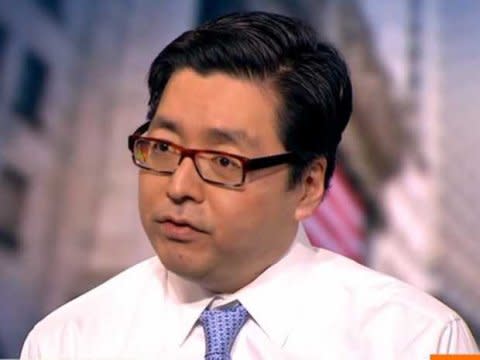JPMorgan's Tom Lee Now Has The Most Bullish Stock Market Forecast On Wall Street

In a note to clients this morning, JPMorgan's chief U.S. equity strategist Tom Lee jacks up his year-end S&P 500 price target to 1775 from 1715.
The new forecast implies an additional 5% upside from Thursday's close at 1690, and it makes Lee the most bullish equity strategist on the Street.
Lee attributes much of the decision to better-than-expected economic data out of the euro area.
" With both U.S. and Europe expected to see better growth in [the second half of 2013], we believe the Street will be in a position to raise 2014E EPS," says Lee. "We are raising 2014E EPS to $120 (vs $117) and also raising our YE 2013E S&P 500 Target to 1775 (up 3.5% vs prior 1715)."
The JPMorgan strategist outlines four reasons for the upgrade:
What is the surprise? Better Europe and eventually EM. Naturally, the question is what will “surprise” the market to drive increased EPS and P/E multiples. In our view, this is driven by improving economic momentum broadly and captured well by the eco surprise indices. As shown in Figure 7, economic surprises have improved sharply for Europe (CESIEUR) and US (CESIUSD) and given the historical GDP beta, should lift Emerging markets as well.
There is pent-up demand in U.S. and to an extent in Europe. As for the U.S. and to a lesser extent for Europe, this is more than “easing financial conditions” but a story of pent-up demand. As shown in Figure 8, investment/durables spending in the U.S. remains at 60-year lows. And at time when the age of capital-stock is near record highs (see Figure 9/Figure 10). This is a formula, in our view, for obsolescence asserting itself in the form of an eventual sharp rise in spending.
Corporate bonds have recovered over 60% of the recent sell-off, supportive of risky assets. Corporate bonds—both high-grade (J.P. Morgan's JULI Index) and high-yield (CSSWHYI Index) exhibited instability (somewhat surprising) in May following the rise in 10-year yields (see Figure 11/Figure 12). Fortunately, much of the dislocation has been retraced. IG spreads have recovered 76% of the widening back to 158bp and, similarly, high-yield spreads have since recovered to 506bp STW, or about 60% of the widening. The point of this is that the tightening of spreads is a positive signal for both risky market "depth" and "liquidity" which are positive for equity relative value.
Equities need to re-rate higher vs corporate bonds—16X? Yes. As we have stated for some time, the equity P/E should be seen via the lens of corporate bond yields (invert a bond yield to derive its P/E). Corporates are payer of both bonds and equities, and as equity earnings (EPS) grow over time (with nominal GDP at least, while coupons are fixed), equity P/E should be higher. Since 1950, equity P/E has been consistently and logically higher than investment-grade P/E. Since 2009, however, as shown in Figure 13, the S&P 500 P/E has been stable at around 13X- 14X for the past 3 years and trades at a steep discount to both investment grade bonds (25X) and to HY (16.2X). At a minimum, we see the equity P/E converging with HY, driven by higher equity P/Es.
What could go wrong? Lee identifies further deceleration in Chinese economic growth and concerns regarding tapering back of Federal Reserve bond purchases as the two main risks to his target.
"Recent data from China is disappointing (IP, GDP) and despite tempered expectations, the government is likely to exercise patience (vs stimulate)," says Lee. "The risk, therefore, is a faster deceleration in GDP growth, something not expected. As for the Fed, the primary concern is how equity markets will hand the start of tapering (rising rates, loss of visibility)."
More From Business Insider

